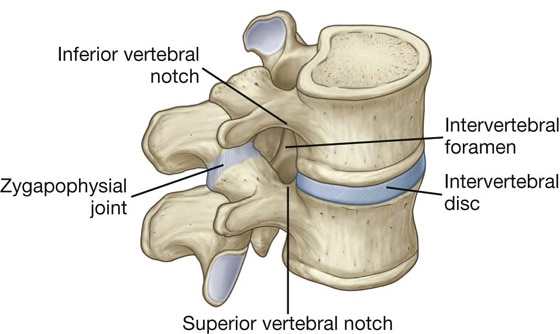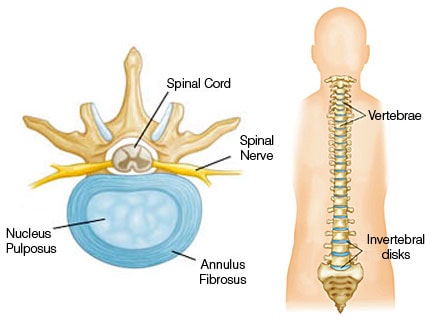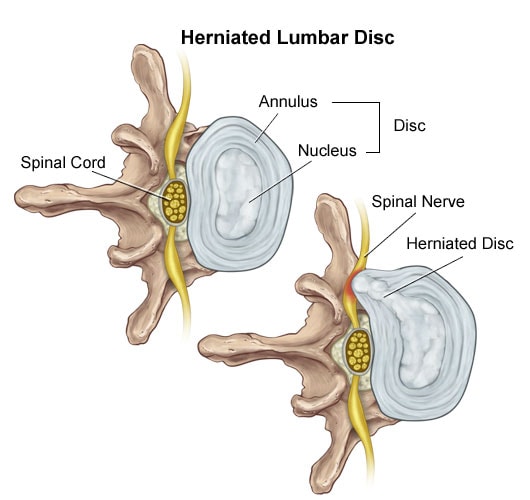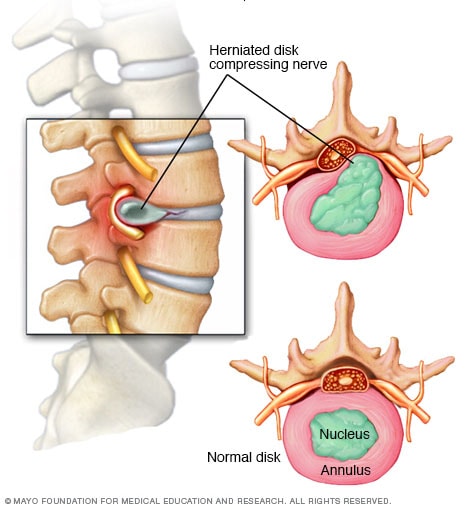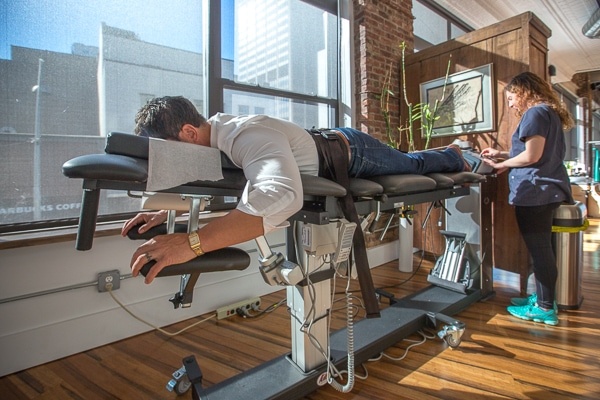Updated. Originally posted 12/30/2016
One of the most common spinal injuries treated at Physio Logic is a herniated disc. To many patients, a herniated disc is also referred to as a slipped disc or pinched nerve.
But what is a herniated disc? How and why does this kind of spinal injury occur? To explain, we need to dive into some anatomy to show you where the problem originates, how it can be treated, and how it can be prevented.
The Intervertebral Disc (IVD)
The intervertebral disc (IVD) is situated between each vertebrae of the spinal column. The IVD is a fibrocartilaginous* cushion that serves as the spine’s shock-absorbing system. It also assists in fluid motion of the spine.
*For those wondering what fibrocartilaginous means, it is cartilage that contains numerous thick bundles of collagen fibers.
Spinal nerves exit between two vertebral segments of the spine. This area is called the intervertebral foramen. These spinal nerves supply all the tissues of the body.
What is the Intervertebral Disc made of?
The IVD is composed of two major layers. This includes the annulus fibrosis and the nucleus pulposus. The annulus is the tough, outer layer of the IVD and is made up of layers of collagen fibers oriented at varying angles. It surrounds the nucleus, which has a higher content of water than the annulus.
You can imagine the IVD being a lot like a jelly donut. Looking at the diagram above, you can see the annulus acting as the dough and the nucleus could be seen as the jelly inside the dough.
Injury to the Intervertebral Disc
The IVD can be a source of pain within the spine or extremities depending on the nature of the injury or episode.
Injury to the IVD is often the result of years of repetitive stress to the neck or back. For example, poor posture puts a great deal of stress on the IVD and over a long period of time can lead to injury. A minor traumatic event, such as bending over to tie your shoes, can cause injury to the disc after years of damage caused by poor posture.
First, there is usually tearing of the annular fibers that occur from the inside, out. This tearing can allow the nucleus to bulge outward into the spinal canal or into the area where the spinal nerves exit. The annulus can also completely tear leading to herniation of the nuclear material into the spinal canal or intervertebral foramen.
Bulging or herniation of the IVD can put pressure on or cause irritation to the spinal nerves. When this occurs it can cause local pain in the region or more commonly radiating pain into the arms or legs.
If the injured disc is a herniated disc in the neck, some herniated disc symptoms could be shooting pain, numbness, tingling, or burning sensations into the arms.
If the injured disc is a herniated disc in the neck lower back, the same herniated disc symptoms can be felt in the legs.
Patients will often also notice weakness in the arms or legs because the spinal nerves supply the muscles, which allows for precise motor control.
Herniated Disc Treatment
There are several conservative treatments available for intervertebral disc syndromes. The idea is to take pressure off of the irritated discs and nerves and decrease pain. This can be accomplished by using Spinal Decompression Therapy, a treatment that stretches the spinal column taking pressure off of the injured discs and the nerves.
Spinal Decompression Therapy begins with a series of sessions typically 2-3 times per week. Each session is approximately 8-12 minutes.
During each session, chiropractic manipulation and electrical muscle stimulation may be used to help relax muscles, decrease pain, and promote further healing of injured tissues.
After treatment, your doctor may prescribe specific exercises designed to help you regain proper control and strength of the muscles providing stabilization. These exercises can help create long-term benefits and prevent future injury.
Finally, medication and/or natural anti-inflammatory supplements may be prescribed to help decrease inflammation caused by the injured IVD. For those patients that do not respond favorably to conservative management, spinal injections or surgical options are also available.
Clinical studies suggest that Spinal Decompression Therapy provides initial relief within just a few sessions for a majority of qualified candidates. This proven, non-surgical approach could help you find the pain relief you need.
Of course, a thorough evaluation by your healthcare professional is required in order to properly diagnose your condition and provide the proper course of treatment.
Interested in Spinal Decompression Therapy, inquire with your local Chiropractor. If you live in the New York City area, schedule a chiropractic evaluation with our Chiropractors in Brooklyn, NY? Just give us a call or start by filling out the form below.
